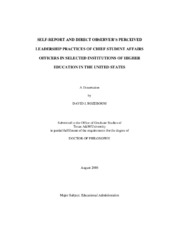| dc.contributor.advisor | Stanley, Christine A. | |
| dc.creator | Rozeboom, David John | |
| dc.date.accessioned | 2010-01-15T00:11:56Z | |
| dc.date.accessioned | 2010-01-16T01:07:05Z | |
| dc.date.available | 2010-01-15T00:11:56Z | |
| dc.date.available | 2010-01-16T01:07:05Z | |
| dc.date.created | 2008-08 | |
| dc.date.issued | 2009-05-15 | |
| dc.identifier.uri | https://hdl.handle.net/1969.1/ETD-TAMU-2936 | |
| dc.description.abstract | The purpose of this study was to determine the perceived leadership practices of chief student affairs officers in the United States in order to establish an understanding of current leadership practices and to assist chief student affairs officers in empowering their organizations to higher levels of excellence and in achieving greater influence in their institutions. Additionally, the researcher examined the relationship between the leadership practices of chief student affairs officers and the leaders in Kouzes and Posner‘s database in order to offer a comparison with a cross-section of this leadership population.
Information on the chief student affairs officers‘ leadership practices was obtained from the self-assessments of 338 chief student affairs officers (using the Leadership Practices Inventory-Self) and from the assessments of 168 observers of the chief student affairs officers (using the Leadership Practices Inventory-Observer) in five key areas: (1) Challenging the Process; (2) Inspiring a Shared Vision; (3) Enabling Others to Act; (4) Modeling the Way; and (5) Encouraging the Heart. Participants rated each of the 30 statements on the Leadership Practices Inventory from one through ten to indicate how frequently the chief student affairs officers engaged in the described behavior. By using the Leadership Practices Inventory, the researcher provides empirical data concerning the perceived leadership behavior of chief student affairs officers in the United States.
An analysis of the data revealed that chief student affairs officers perceive themselves as strong and effective leaders. The observers of the chief student affairs officers confirm this finding. A statistical analysis of the data demonstrated the existence of significant predictors related to level of education and type of institution for each of the five leadership practices as identified by Kouzes and Posner and confirmed in this study. However, the practical significance was found to be minimal. Additionally, the constructs for leadership practice differed somewhat from those of Kouzes and Posner. Also, the chief student affairs officers‘ self-described leadership ratings, when compared to those in the Leadership Practices Inventory database, tended to be in the high range (ranging from the 63rd percentile to the 77th percentile). | en |
| dc.format.medium | electronic | en |
| dc.format.mimetype | application/pdf | |
| dc.language.iso | en_US | |
| dc.subject | Leadership | en |
| dc.subject | Practices | en |
| dc.subject | Chief Student Affairs Officers | en |
| dc.subject | Higher Education | en |
| dc.title | Self-report and Direct Observer's Perceived Leadership Practices of Chief Student Affairs Officers in Selected Institutions of Higher Education in the United States | en |
| dc.type | Book | en |
| dc.type | Thesis | en |
| thesis.degree.department | Educational Administration and Human Resource Development | en |
| thesis.degree.discipline | Educational Administration | en |
| thesis.degree.grantor | Texas A&M University | en |
| thesis.degree.name | Doctor of Philosophy | en |
| thesis.degree.level | Doctoral | en |
| dc.contributor.committeeMember | Boyd, Barry L. | |
| dc.contributor.committeeMember | Cole, Bryan R. | |
| dc.contributor.committeeMember | Tolson, Homer | |
| dc.type.genre | Electronic Dissertation | en |
| dc.type.material | text | en |
| dc.format.digitalOrigin | born digital | en |


